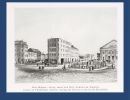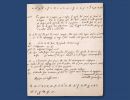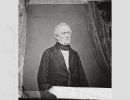Right to Life, Liberty and the pursuit of Happiness
The American Revolution of the «Thirteen United Colonies» against Great Britain (1775-1783) was based on the classical republican ideal par excellence, i.e. that of the virtuous citizen who sacrifices his private interest for the achievement of public freedom.
The Declaration of Independence of the United States, whose primary author is considered to be Thomas Jefferson, echoed the ideas of the Enlightenment. The final draft of the Declaration was approved by Congress on 4 July 1776 and is regarded as the act of founding of the United States of America. Based on the formulation of the doctrine of rights of John Locke, this major revolutionary text influenced the ideas and spirit of the French Declaration of Human and Citizen’s Rights (1789). Consequently, it also played an important role in the ideology of the Greek Revolution.
The Land of Liberty in Grecian Cloak
The American Revolution ushered a keen interest in Greek Antiquity in the letters and the arts and an impetus for the discovery of Greece through travel. A new trend in classical learning turned the cities of Philadelphia and Boston into proud versions of Athens. In the decades after American independence, the atmosphere of liberty in Philadelphia spawned an artistic spirit that earned this city its reputation as the Athens of America, while among the educated elite of Boston at Harvard, a movement was born to upgrade the study of Greek and produce accurately printed Greek texts. The interest in Athens and Grecian art furnished America the new identity that it desired showcasing a break from Europe and Neoclassicism. America’s Greek Revival style (1820-1860) opted for the revival of an ancient culture with similar interests and functions rather than a new and modern invention. Architects Benjamin Henry Latrobe (1764-1820) and William Strickland (1788-1854) were pioneers of the Greek Revival style, whose “Temple design” offered the new nation of the United States the desired trappings of monumentality and dignity during the period when many of the foundational public buildings of the United States government were constructed.
Edward Everett: The foremost American Hellenist
Best known as an inspired orator, Edward Everett (1794–1865) was a classicist who became a passionate supporter of the Greek War of Independence. After 1824, he held a number of political offices, including Governor of Massachusetts, and senator.
In 1815, Everett was appointed the first Eliot Professor of Greek Literature at Harvard. He went to Europe to study at the University of Göttingen, and also stayed in Paris, where he met Adamantios Korais and learned modern Greek. He finally spent time in Greece in 1819. Upon his return to Harvard in 1820, he taught Greek language and literature to university students in accordance with European standards, and offered public lectures on the antiquities of Greece — the first ones to be delivered to a public audience in America. In the 1820s, he mounted a concerted campaign in America to tilt classical studies to Greek and Hellenism.
-
The Declaration of Independence of the United States, 1776.
The Declaration of Independence of the United States, 1776.

-
greek revival3
The first edition of Dionysios Solomos’s Hymn to Liberty printed in Greece. Inno alla Liberta Dionisio Solomos... scrisse il mese di Maggio 1823. Volgarizzato in prosa italiana da G. Grassetti. 3rd ed. Missolonghi, 1823.
Gennadius Library, American School of Classical Studies at Athens
-
Inno alla Liberta Dionisio Solomos
Dionysios Solomos, Hymn to Liberty, stanza 22:
Heartily with joy salutes thee/That free land of Washington,/ Mindful of the bonds that fettered/ Her own limbs, not long agone.
Transl. Florence McPherson, 1884
Gennadius Library, American School of Classical Studies at Athens
-
greek revival4
First American Edition of Xenophon’s Cyropaedia edited by Johannis Watts and printed in Philadelphia by Wm. Poyntell et Soc in 1806.
Gennadius Library, American School of Classical Studies at Athens
-
greek revival5
Eliza Robbins, Grecian History. Adapted to the use of schools, and young persons. New York: Roe Lockwood, 1833.
Konstantinos Arniakos Collection
-
greek revival6
John H. Manning and David B. Gulick, View of Haymarket Square, Boston, Massachusetts. 1853. Engraving.

-
greek revival7
The greatest example of the Greek Revival architectural style is the United States Capitol Building; its construction began in 1793.
This historic photograph shows Abraham Lincoln delivering his first inaugural address as the sixteenth President of the US on March 4, 1861.
The Capitol is still under construction.
-
greek revival8
William Strickland, Second Bank of the United States, Philadelphia (1819–1824). Façade and interior view. Historic American Buildings Survey,
Photograph by Frederick D. Nichols, Cervin Robinson, and Jack E. Boucher. Documentation Compiled After 1933
-
greek revival9
Nicholas Biddle of Philadelphia was one of the first Americans to visit and write about Greece in 1806. Under his backing as President of the Second Bank,
William Strickland’s impressive design was adopted by branches of the bank across the country.
Printed bank draft partly accomplished in manuscript, and signed by Nicholas Biddle, Philadelphia, 1836.
Gift of Curtis Runnels
-
greek revival10
Horatio Greenough’s Statue of George Washington, 1832-1840. Installed in the Capitol Rotunda after its completion (1840), the bare-chested image turned out to be the most controversial portrait of Washington. The statue is now located in the Smithsonian National Museum of American History, Washington, DC
Photograph of 1964.
-
greek revival11
Antoine-Chrysostome Quatremère de Quincy, Le Jupiter olympien,
ou L’art de la sculpture antique considéré sous un nouveau point de vue. Paris: Chez Firmin Didot, 1815
-
greek revival14
Nikolaos Tsiklitiras, a native of Navarino, was a teacher of Modern Greek in Boston; among his students were the linguist
John Pickering (with whom they corresponded in Italian) and William Jenks, a professor of oriental languages at Bowdoin College.
Nikolaos Tsiklitiras, Handwritten notes with fragments of language assignments and exercises in Modern Greek. Boston 1818.
American School of Classical Studies at Athens, Archives. Curtis Runnels Collection
-
greek revival15
Nikolaos Tsiklitiras, Handwritten notes with fragments of language assignments
and exercises in Modern Greek. Boston 1818.
American School of Classical Studies at Athens, Archives. Curtis Runnels Collection
-
greek revival16
Nikolaos Tsiklitiras, Handwritten notes with fragments
of language assignments and exercises in Modern Greek. Boston 1818.
American School of Classical Studies at Athens, Archives. Curtis Runnels Collection
-
greek revival17
Pickering’s study on the pronunciation of modern Greek in conjunction with the travels of Edward Everett in Greece in 1819,
would revolutionize the teaching of modern Greek in America.
Review of John Pickering’s, An Essay on the Pronunciation of the Greek Language, Cambridge, Massachusetts, 1818.
American School of Classical Studies at Athens, Archives. Curtis Runnels Collection
-
Visionaries11
Edward Everett (1794-1865) was a classicist who became a passionate supporter of the Greek cause.
Stereoscopic photograph. The US National Archives
-
Visionaries12
In Boston, Everett presented his public lectures on the antiquities of Greece in front of a panorama of Athens that contributed to their vividness and popularity. The panorama was probably based on one painted by Edward Dodwell and Simone Pomardi, created using the camera obscura. After it was shown in London in 1818, the panorama was acquired for Harvard University by Everett’s friend Theodore Lyman, Jr. “for the gratification and instruction of the students of the University.” Ιt arrived in 1820 but was destroyed by fire in 1845.
Panorama of Athens, 1805. Dodwell Collection, no. 221. Courtesy of the Packard Humanities Institute
-
greek revival12
Colonel Alexander Negris, a distinguished veteran of the Greek War of Independence, taught modern Greek at Harvard for two years (1827—1828). He published a Grammar of the Modern Greek Language in 1828, the first grammar of modern Greek in the New World, so that Americans might become “acquainted with the living dialect of Greece.”
Alexander Negris, A dictionary of modern Greek proverbs, with an English translation, explanatory remarks, and philological illustrations. Edinburgh: T. Clark, 1831.
Gennadius Library, American School of Classical Studies at Athens
-
greek revival13
Evangelinos Apostolides Sophocles (1807—1883) was born at Tsangarada on Mt. Pelion in Thessaly and was educated at St. Catherine’s Monastery in Sinai. He came to Boston in 1828 with the missionary Josiah Brewer and studied at Amherst. From 1842 until his death he taught Greek at Harvard.
Evangelinos Apostolides Sophocles, Greek lexicon of the Roman and Byzantine periods (from B.C. 146 to A.D. 1100). Boston: Little, Brown, and Co., 1870.
Gennadius Library, American School of Classical Studies at Athens
The Declaration of Independence of the United States, 1776.
The first edition of Dionysios Solomos’s Hymn to Liberty printed in Greece. Inno alla Liberta Dionisio Solomos... scrisse il mese di Maggio 1823. Volgarizzato in prosa italiana da G. Grassetti. 3rd ed. Missolonghi, 1823.
Gennadius Library, American School of Classical Studies at Athens
Dionysios Solomos, Hymn to Liberty, stanza 22:
Heartily with joy salutes thee/That free land of Washington,/ Mindful of the bonds that fettered/ Her own limbs, not long agone.
Transl. Florence McPherson, 1884
Gennadius Library, American School of Classical Studies at Athens
First American Edition of Xenophon’s Cyropaedia edited by Johannis Watts and printed in Philadelphia by Wm. Poyntell et Soc in 1806.
Gennadius Library, American School of Classical Studies at Athens
Eliza Robbins, Grecian History. Adapted to the use of schools, and young persons. New York: Roe Lockwood, 1833.
Konstantinos Arniakos Collection
John H. Manning and David B. Gulick, View of Haymarket Square, Boston, Massachusetts. 1853. Engraving.
The greatest example of the Greek Revival architectural style is the United States Capitol Building; its construction began in 1793.
This historic photograph shows Abraham Lincoln delivering his first inaugural address as the sixteenth President of the US on March 4, 1861.
The Capitol is still under construction.
William Strickland, Second Bank of the United States, Philadelphia (1819–1824). Façade and interior view. Historic American Buildings Survey,
Photograph by Frederick D. Nichols, Cervin Robinson, and Jack E. Boucher. Documentation Compiled After 1933
Nicholas Biddle of Philadelphia was one of the first Americans to visit and write about Greece in 1806. Under his backing as President of the Second Bank,
William Strickland’s impressive design was adopted by branches of the bank across the country.
Printed bank draft partly accomplished in manuscript, and signed by Nicholas Biddle, Philadelphia, 1836.
Gift of Curtis Runnels
Horatio Greenough’s Statue of George Washington, 1832-1840. Installed in the Capitol Rotunda after its completion (1840), the bare-chested image turned out to be the most controversial portrait of Washington. The statue is now located in the Smithsonian National Museum of American History, Washington, DC
Photograph of 1964.
Antoine-Chrysostome Quatremère de Quincy, Le Jupiter olympien,
ou L’art de la sculpture antique considéré sous un nouveau point de vue. Paris: Chez Firmin Didot, 1815
Nikolaos Tsiklitiras, a native of Navarino, was a teacher of Modern Greek in Boston; among his students were the linguist
John Pickering (with whom they corresponded in Italian) and William Jenks, a professor of oriental languages at Bowdoin College.
Nikolaos Tsiklitiras, Handwritten notes with fragments of language assignments and exercises in Modern Greek. Boston 1818.
American School of Classical Studies at Athens, Archives. Curtis Runnels Collection
Nikolaos Tsiklitiras, Handwritten notes with fragments of language assignments
and exercises in Modern Greek. Boston 1818.
American School of Classical Studies at Athens, Archives. Curtis Runnels Collection
Nikolaos Tsiklitiras, Handwritten notes with fragments
of language assignments and exercises in Modern Greek. Boston 1818.
American School of Classical Studies at Athens, Archives. Curtis Runnels Collection
Pickering’s study on the pronunciation of modern Greek in conjunction with the travels of Edward Everett in Greece in 1819,
would revolutionize the teaching of modern Greek in America.
Review of John Pickering’s, An Essay on the Pronunciation of the Greek Language, Cambridge, Massachusetts, 1818.
American School of Classical Studies at Athens, Archives. Curtis Runnels Collection
Edward Everett (1794-1865) was a classicist who became a passionate supporter of the Greek cause.
Stereoscopic photograph. The US National Archives
In Boston, Everett presented his public lectures on the antiquities of Greece in front of a panorama of Athens that contributed to their vividness and popularity. The panorama was probably based on one painted by Edward Dodwell and Simone Pomardi, created using the camera obscura. After it was shown in London in 1818, the panorama was acquired for Harvard University by Everett’s friend Theodore Lyman, Jr. “for the gratification and instruction of the students of the University.” Ιt arrived in 1820 but was destroyed by fire in 1845.
Panorama of Athens, 1805. Dodwell Collection, no. 221. Courtesy of the Packard Humanities Institute
Colonel Alexander Negris, a distinguished veteran of the Greek War of Independence, taught modern Greek at Harvard for two years (1827—1828). He published a Grammar of the Modern Greek Language in 1828, the first grammar of modern Greek in the New World, so that Americans might become “acquainted with the living dialect of Greece.”
Alexander Negris, A dictionary of modern Greek proverbs, with an English translation, explanatory remarks, and philological illustrations. Edinburgh: T. Clark, 1831.
Gennadius Library, American School of Classical Studies at Athens
Evangelinos Apostolides Sophocles (1807—1883) was born at Tsangarada on Mt. Pelion in Thessaly and was educated at St. Catherine’s Monastery in Sinai. He came to Boston in 1828 with the missionary Josiah Brewer and studied at Amherst. From 1842 until his death he taught Greek at Harvard.
Evangelinos Apostolides Sophocles, Greek lexicon of the Roman and Byzantine periods (from B.C. 146 to A.D. 1100). Boston: Little, Brown, and Co., 1870.
Gennadius Library, American School of Classical Studies at Athens





















